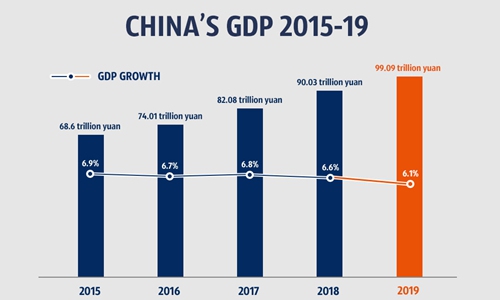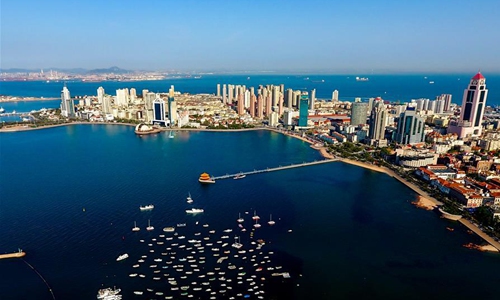HOME >> SOURCE
China’s GDP grows 6.1% in 2019 despite trade war sting
By Chu Daye Source:Global Times Published: 2020/1/17 10:00:50 Last Updated: 2020/1/17 23:25:17

The Chinese economy grew 6.1 percent for 2019, in line with the 6-6.5 percent goal as the world's second-largest economy demonstrated resilience with an improved structure to cap a year marked by a US-driven trade war, official data showed.
Overall, China's GDP grew 6.1 percent to 99.09 trillion yuan ($14.4 trillion) for 2019, according to data from the National Bureau of Statistics (NBS).
Friday's GDP reading indicated a continued slowdown for China's economic growth from 6.6 percent in 2018 and 6.8 percent in 2017.
It is the weakest reading in 29 years but in line with the 6-6.5 percent annual growth target.
China's GDP expansion in 2019, at about 9.06 trillion yuan ($1.32 trillion), exceeded the 2018 annual GDP of Mexico, the world's 15th largest economy.
In the fourth quarter of 2019, China's economy expanded 6.0 percent year-on-year, compared with the 6.0 percent growth in the third quarter, 6.2 percent in the second quarter and 6.4 percent in the first quarter.
The data is closely watched by global markets analysts and is used to gauge the performance of the world's second-largest economy in a year characterized by slow economic growth and contracting trade. It is also used to access China's growth potential for 2020, which is expected to be a challenging year.
"The newly released data was basically in line with market anticipation, or even better than some institutions have forecast," Lian Ping, chief economist at Bank of Communications, told the Global Times on Friday.
Chinese economists said the growth was the result of the country's improved economic structure which included a steady transition from manufacturing to the services sector. Financial deleveraging and debt stabilization from the past two years also helped.
The resilience of China's economy in 2019 reflected the continued strength of private consumption spending, supported by a wide range of monetary and fiscal policy stimulus measures, said Rajiv Biswas, APAC chief economist at IHS Markit.
China's total retail sales of consumer goods rose 8%year-on-year in 2019 to hit 41.16 trillion yuan ($5.99 trillion), Friday's data showed.

Photo: Xinhua
Still a growth engine
China champions globally with its 2019 GDP growth, NBS head Ning Jizhe said at a press conference on the release of the major annual economic data on Friday.
China's 2019 GDP, nearing 100 trillion yuan ($14.54 trillion), roughly equals to the sum of the 2018 GDP of Japan, Germany, the UK and France combined, said Ning.
The country's GDP per capita surpassed the $10,000 mark last year, making a historic breakthrough, said Ning. The per capita GDP hit $10,276 in 2019, the data showed.
Ning predicted China to contribute about 30% to the global economic growth in 2019. "China is still the locomotive with the strongest driving force for the global economic development," he said.
The 2019 GDP performance laid a solid foundation for China to achieve new progress during the 14th Five-Year Plan (2021-25), Niu Li, a senior economist at the State Information Center, told the Global Times.
The Chinese economy is also headed toward positive growth in the mid- and long-term with emerging industries and services sector expansion driven by the world's largest consumer market with 400 million middle-class consumers, Niu said.
6.0% growth benchmark
Friday's GDP reading will serve as a reference among Chinese economists on whether the country would maintain a key psychological level of six percent growth rate in 2020. Officials will publish the country's GDP growth target in March.
The data also follows a phase one trade deal inked between China and the US on Wednesday. Analysts believe the deal will shore up China's GDP growth in 2020. Exports are a key component of GDP statistics but China's foreign trade contracted a small margin in US dollars in 2019, and partly due to the 22-month trade dispute with the US, according to the Chinese customs authority.
The negative impact from the tariff increases should diminish after the second quarter, and China's export growth is expected to return to positive territory in 2020, Tang Jianwei, an economist at Bank of Communications, told the Global Times, adding that there will be a pick-up in risk appetite in manufacturing investment due to improved outlook in trade with the US.
The phase one deal could boost China's GDP growth to 6 percent in 2020 as opposed to an earlier forecast of 5.8 percent, according to the International Monetary Fund (IMF).
Challenges
Niu Li, the economist at the State Information Center, pointed out the turbulent external environment so far in 2020, such as the US-Iran conflict, needs to be monitored.
There are also risks that the US might go back on its words to escalate the trade war against China, and there would be back-and-forth in trade talks between the two major economies, adding certainty to the already fragile world economy.
Rising inflation spurred by an African swine fever outbreak that sent pork prices soaring, is another factor, according to analysts, that could hinder GDP growth.
Biswas pointed out that Chinese policymakers may not need to dig too deep into their policy toolkit during 2020, after having used a wide range of monetary policy and fiscal policy stimulus measures during 2019 when the trade war with the US was at its peak.
However, "if additional measures are needed during 2020, the scope for additional monetary policy measures may be constrained by the recent pick-up in headline inflation, at least till inflation pressures from higher foods prices ease off," Biswas said.
RELATED ARTICLES:
Posted in: ECONOMY